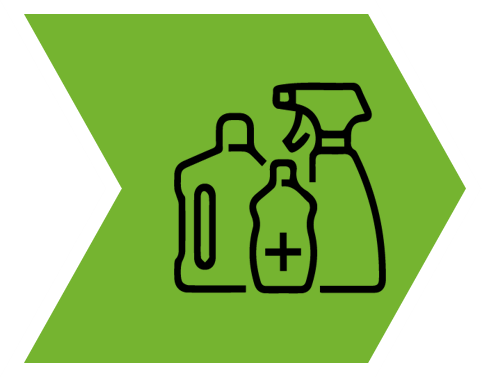MRSA Prevention is a complex and multifaceted effort. This Toolkit highlights four key strategic areas where intervention and improvement can have the greatest impact in MRSA prevention. How you approach tackling these areas depends on what is right for your facility or unit.
Select this interactive graphic to explore more on each of the Four Key Strategies of MRSA Prevention.
 Decolonize Patients
Decolonize Patients Decontaminate the Environment
Decontaminate the Environment Prevent Person-Based Transmission
Prevent Person-Based Transmission Prevent Device/Procedure Infections
Prevent Device/Procedure Infections- Targeting MRSA
Importance of MRSA Prevention
While it is widely known that MRSA is undesirable, not everyone fully understands its impact. This section provides an overview of MRSA and the preventable harm it can cause, making the case for MRSA Prevention.

Decolonize Patients
Decolonization is one of the most effective and impactful methods to prevent in MRSA. This toolkit includes tools, guides, and resources to assist in the implementation of decolonization in your unit or facility.
- Decolonization: Learn more about Decolonization, including evidence and implementation, through educational materials..
- Tools & Resources for Decolonization: Access guides, protocols, training materials, and patient resources to assist setup and implementation of decolonization.
- MRSA Surveillance: Surveillance can be interrelated with decolonization, so it is included here as an adjunct topic.

Decontaminate the Environment
A contaminated patient environment is a primary pathways for transmission of MRSA. High-touch surfaces and fomites in the patient care settings can harbor MRSA and other pathogens, facilitating transmissions directly or indirectly between patients. Therefore, thorough decontamination of the environment is crucial for preventing transmission.
- Environmental Cleaning: Explore strategies to optimize and assess Environmental Cleaning for effective MRSA prevention.

Prevent Person-based Transmission
Healthcare personnel can inadvertently pick up MRSA from a patient or the patient care environment and transmit it to other patients, leading to colonization or infection. Preventing person-based transmission is hugely important to reducing HAIs and MDROs, including MRSA.
- Contact Precautions: Learn about utilizing contact precautions to prevent spread of HAIs.
- Hand Hygiene Promotion: Explore strategies for effective implementation of hand hygiene policies.
- MRSA Surveillance: Review the latest evidence and recommendations for MRSA surveillance.

Prevent Device/Procedure Infections
Medical devices and procedures are often necessary and lifesaving, but they increase patients' risk of infection by MRSA and other HAIs. Preventing device- and procedure-related infections is crucial to lower this risk and prevent MRSA.
- Prevention of CLABSI: Learn effective strategies to prevent Central Line-Associated Bloodstream Infections (CLABSI).
- Prevention of VAP & NV-HAP: Learn effective strategies to prevent Ventilator-Associated Pneumonia (VAP) and Non-Ventilator Hospital-Acquired Pneumonia (NV-HAP).

Fundamental Best Practices
These stewardship topics do not align with one specific strategic area, but instead represent vital best practices that underpin all the Four Key Strategies for MRSA Prevention. These topics have been highlighted separately as fundamental best practices to underscore their particular importance.
- Antibiotic Stewardship: Learn about developing and improving an antibiotic stewardship program.
- Blood Culture Practices and Stewardship: Learn strategies and best practices to optimize blood culture collection, reduce contamination, and improve diagnostic accuracy.



